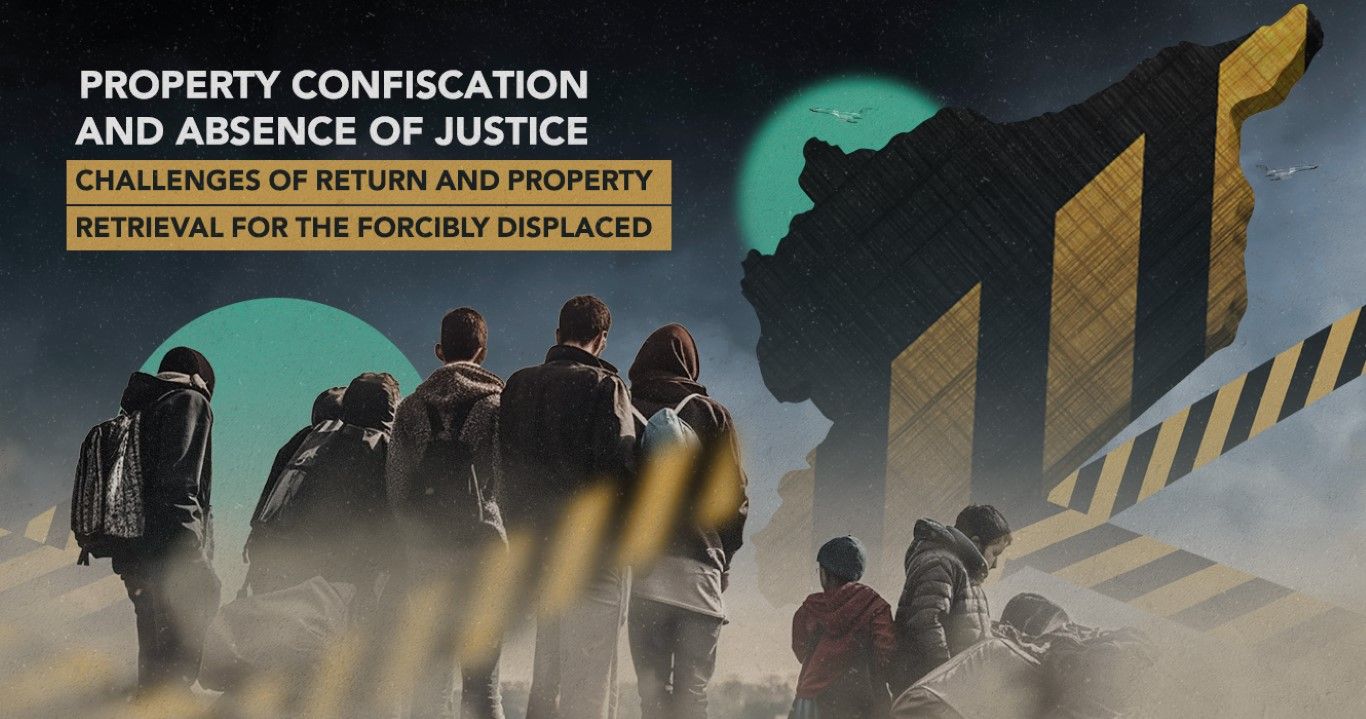The Syrian regime has issued several laws related to real estate organization and the establishment of regulatory regions, including Law No. 66 of the year 2012 and Law No. 10 of the year 2018. Such laws aim to strip the displaced Syrians of their property and rights through expediting the process of transferring real estate ownership from the original owners of the Syrian people, especially the opposition, to parties loyal to the regime. Syrian jurists have interpreted these laws as aiming to confiscate the property of the forcibly displaced and the IDPs who are unable to return to their homes located in the areas currently under the control of the Syrian regime.
In practice, these laws were used to carry out forcible removal and displacement of dissidents and civilians from specific areas, and to grant their lands and possessions to members affiliated to the regime and its loyal parties. This measure aims to tighten the political and economic grip of the Syrian regime, and to provide financial resources and support to the forces affiliated with it. These laws take advantage of the challenging circumstances, that the population in Syria suffer from, due to the ongoing conflict. Moreover, these policies lead to the displacement of more people and the exacerbation of the humanitarian crisis in the country.
It is also worth noting that this behavior is not exclusive to the Syrian regime; rather, it is a traditional tactic used by some authoritarian regimes to consolidate their control and entrench loyalty to them by seizing property and economic resources.
Historically, the implementation of Demographic Change Policy in Syria dates back to the rule of Hafez al-Assad and is continuing under the rule of Bashar al-Assad. This policy aims to redistribute society and change the demographic composition of the opposition areas by forcing civilians to flee or displace them from their areas of origin.
The term “Useful Syria” refers to the most stable and tightly controlled part of the country by the Syrian regime and its allies. It is the part that contains the significant economic and natural resources. In this sense, IDPs and dissidents, who reside in other areas outside government control, are not “useful” for the regime.
Therefore, when seeking to find effective solutions that guarantee the safe return of nearly 13 million displaced Syrians, we must point out that the forced displacement, that was carried out by the Syrian regime and its Iranian and Russian allies, was not merely a result of the conflict, but rather a well-thought-out policy and plan that has been implemented since the rule of Hafez al-Assad. Such plan aims to achieving strategic goals within the policy of demographic change in order to serve what is later known as “Useful Syria”.
The Syrian Network for Human Rights released a report on May 25, 2023, titled “All the laws through which the Syrian regime controlled real estate and land ownership in Syria before and after the popular movement in March 2011.”
This report discusses number of significant points, starting with the laws and legislation that the Syrian regime passed after March 2011, and their significant impact on the real estate issue. The report highlights the regime’s exploitation of widespread destruction as a tool to seize and loot land and real estate, in addition to the impact of the problem of missing civil documents on the real estate issue. The report also addresses the issue of security permits and how they are used as a tool to prevent political opponents from disposing of their property.
The report concludes that the Syrian regime’s control over the legislative process and its exploitation of laws and legislation aims to seize control of the property and lands of the opponents and the three categories: 12 million forcibly displaced persons, 112 thousand forcibly disappeared persons, and half a million deceased persons who are not registered in the civil registry.
The report emphasizes the Syrian regime’s extensive use of administrative barriers to maintain control over the properties and lands of these three categories in the future. This is conducted through taking complicated administrative procedures; such as issuing death certificates and verifying the legal status of unregistered deceased people, in addition to requesting security permits for displaced persons and refugees.
The report also indicates that the Syrian regime has used a variety of tools to control land and real estate, as well as has attempted to amend existing laws and pass new ones to seize real estate in Syria. The following is a summary of all the policies used by the Syrian regime in its acquisition of real estate properties:
- The Syrian regime has passed laws and decrees to control real estate ownership and transfer the majority of areas to its direct authority.
- The Syrian regime issued several laws after 2011 that have a significant impact on real estate matters and granted it broad authority to dispose of land and property.
- The Syrian regime has used the widespread devastation as a means to forcibly drive people from their homes while looting real estate in the areas that were destroyed.
- The regime has put administrative barriers before the opponents and the three mentioned categories (the displaced, the forcibly disappeared, and the unregistered deceased) to prevent them from disposing of their property inside Syria.
- The Syrian woman’s right to own real estate has been affected by the challenges she faces in obtaining her rights and being exploited by the regime.
- The regime has imposed security permits on real estate transactions as that is considered a weapon against political opponents.
- The real estate laws issued by the Syrian regime contain inconsistencies, duplicate specializations, and confusion in terms of reference within the organizations in charge of enforcing them.
The Syrian Association for Citizens’ Dignity (SACD) has previously addressed the issue of Confiscating Property and Agricultural Lands carried out by the Syrian regime in the countryside of Idlib and Hama through announcing land auctions within the areas that the regime took control of during its campaign on Idlib. Such procedure has led to the displacement of most of the region’s residents to the areas outside the control of the regime.
The Administrative Order Committee appointed by the Major General, head of the Military and Security Committee in Hama, issued a decision on August 2020, referring to the lands belonging to the displaced people in areas that were controlled by “armed terrorist groups,” using a language indicated that merely being present in those areas is considered a crime that grants the regime the right to invest the displaced people’s lands. These decisions varied in both content and mechanism as some of them being made in the form of tenders to guarantee the investment of lands with fruit trees, as it is the case with pistachio-planted lands in Al-Lataminah, Latmin, Kafr Zita, and Al-Zakat areas, in yet another painful way of taking advantage of farmers who toiled on those lands all year, but were forced to leave them during the regime’s latest military campaign. The same scenario has been repeated with regard to the olive crop in a number of lands in the Al-Ghab region.
The dilemma faced by displaced Syrians, who are victims of the regime’s property confiscation policy, which is evident in Hama, supports the findings of the report of the Syrian Association for Citizens’ Dignity which was released in 2019 under the title “Between the Hammer and the Anvil: Motives and Experiences of Syrians Forced to Return to Areas Under Assad’s Control.” The report demonstrates that among the small number of displaced Syrians who decided to return to areas controlled by Assad, despite the security risks, nearly 25 percent of all respondents were motivated by concern over the regime seizing their property. Evidences indicate that the majority of those individuals (42%) have come from the countryside of Damascus, so it means that this is related to worries about the regime’s “real estate development” laws in this regard, including Law No. 10, which was issued with the aim of seizing people’s property in the areas occupied by the regime and to consolidate the demographic change.
On the other hand, the Syrian Association for Citizens’ Dignity shed light on the attempts of the Iranians to seize the property of the residents in the city of Deir ez-Zor in the article “Deir ez-Zor and the Few Options with the Start of “The Widely Rejected Reconciliation” which focused on the reality of the city after it was taken over by the Syrian regime forces and the transformations that affected the city and its residents.
The article also referred to the ongoing demographic change in the city of Deir ez-Zor and the Iranian role after Iran has taken control of parts of the region. Accordingly, the Iranian militias have attempted to approach the remaining civilians and offer them assistance in an effort to gain their loyalty and deny any potential future accusations.
Iranian militias have managed the process of land seizure in a way that served Iran’s interests. An example of that is the involvement of Hajj Askar, a military and security official in the Iranian Revolutionary Guards, in the purchase of real estate worth more than 400 million Syrian pounds in a very short time.
In addition, the Iran-affiliated militias have confiscated the property of the displaced people in cities such as Abu Kamal, Mayadin, Al-Asharah and Al-Muhasan. The strategy used to accomplish that was confiscating the properties on the grounds that these properties had no owners. The Syrian regime has also demanded that these properties should be sold and the amounts collected should be invested in private accounts.
The Syrian Association for Citizens’ Dignity interviewed Mr. (A.H) from Qaboun neighborhood and currently residing in the capital, Damascus, who talked about his experience of displacement and the current situation in Qaboun neighborhood where he was forcibly displaced together with his wife and sick mother in 2012.
When asked if their home was demolished after the displacement agreement, he confirmed, “Yes, absolutely.” He also explained that they tried to obtain a security permit to enter the neighborhood only to find that their homes and buildings had been completely demolished, and instead they found rubble and destruction, saying: “I neither found home, nor neighborhood, or anything from our old memories. Our neighborhood was just masses of debris and destruction.”
Mr. (A.H) has talked about the rationale behind demolishing the houses in this manner, saying: “First, it is no secret that the neighborhood is located within a block of the military barracks of the Syrian regime forces, which were the first points targeted by the opposition factions. Then, the demolition came as a form of revenge.” He also referred to the opposition factions’ refusal to compromise and reconcile in the neighborhood, which made them a target for destruction.
With regard to rebuilding homes or restoration works, Mr. (A.H) had confirmed that return was prohibited and that following the passage of Law No. 10 of 2018, the governorate demanded documents attesting to real estate ownership in order to grant individuals shares in the new organizational charts. He also indicated that they submitted the required documents two years ago, but no progress has been implemented so far.
Mr. (A.H) has concluded his statement by saying: “Until now, none of the promises made have been fulfilled, and the neighborhood’s conditions of destruction and rubble remain the same. And when we go to the governorate offices to inquire, they inform us that there is nothing new yet and that we have to wait.”
While it is obvious that the Syrian regime utilizes discriminatory legislation and executive orders of the kind we have described as a part of implementing the policy of forced displacement and permanent demographic change, the displaced Syrians and the international community must realize that this reality created by force and discrimination must be stopped and changed in order to achieve stability and peace. In this regard, we can rely on the international legal framework that guarantees ownership rights of the displaced people everywhere, and we can benefit from the experience of Bosnia and Herzegovina, where such policies were implemented. The Bosnian Serb command followed an almost identical policy of appropriating and confiscating properties from the Bosnian Muslims and Bosnian Croats who lived in the areas invaded by the Serbs. Lands and property were confiscated, and laws were issued to distribute them to Serbian fighters and capital owners, which is almost similar to what the Syrian regime has been practicing.
Despite of that, these policies were reversed in the Dayton Peace Agreement, specifically Annex No. 7, which addressed the rights of displaced Bosnians. A Committee for the displaced and refugees was formed as part of this framework with the specific objective of resolving property claims in situations where the properties of the displaced people have been seized or confiscated. The formed committee was authorized to receive contestation applications pertaining to real estate property in Bosnia and Herzegovina and process the applications and return the rights to their owners. The committee processes cases where the property was not voluntarily sold or otherwise transferred prior to the start of the Bosnian War and when the property was not in the possession of the owner at the end of the Bosnia and Herzegovina war.
The Bosnian example highlights the importance of a comprehensive political solution that guarantees the rights of displaced Syrians as a necessary prerequisite for any safe, voluntary and dignified return. This must remain the objective of all displaced Syrians, whose top priority is making sure that their rights are at the heart of any political solution. Only as a result of that, the criminal policies, such as the confiscation of the private property of displaced Syrians, will be reversed and abolished.
Most of the real estate laws issued by the Syrian regime violate human rights. So, the international community and the United Nations must denounce the regime’s hegemony, expose its practices of property theft, and cooperate with legal organizations to document these practices, decrees, and laws passed by the regime, expose their violation of international human rights law, and condemn the resulting consequences.
Achieving justice in cases of property confiscation requires strong legal and political interventions, and the safe environment can only be achieved after achieving justice in Syria, getting rid of the Syrian regime, and holding those responsible accountable for all violations. A comprehensive and sustainable political solution is the first step and the cornerstone for achieving the voluntary, safe and dignified return of the displaced and Syrian refugees.
Analyzing the impact of forced displacement and demographic change policies on the various components of Syrian society and the role and objectives of actors involved in their displacement is considered an essential procedure to identify the repercussions of this policy and developing effective solutions for the resulting humanitarian crisis. The Syrian Association for Citizens’ Dignity believes that securing a safe environment in which justice is achieved and the rights and property of the displaced are preserved is a prerequisite for any safe, voluntary and dignified return of the displaced Syrians.


